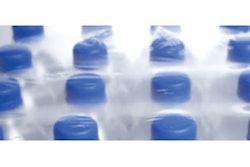In the soft drink wars, a new battle is being waged. In March, PepsiCo threw its hat into the sustainable soft-drink packaging ring, one-upping The Coca-Cola Company’s 30% plant-based PET PlantBottle with one PepsiCo claims will comprise 100% renewable resources. Whereas Coke’s PlantBottle is made with 30% sugarcane, PepsiCo says it will create a PET bottle that uses materials such as switch grass, pine bark, and cornhusks. In the future, the company says it will broaden the renewable sources used to create the bottle to include orange peels, potato peels, oat hulls, and other agricultural byproducts from its foods business.
When asked about the development at the Sustainable Packaging Symposium 2011, The Coca-Cola Co.’s Scott Vitters, general manager of the PlantBottle Packaging Platform, noted that Coke has proven in a lab environment that it is possible to create a PET bottle with 100% renewable resources. “The question is, is it scalable and sustainable,” he asked.
PepsiCo believes it is. In an exclusive interview with Greener Package, PepsiCo’s Denise Lefebvre, director of Advanced Research – Beverage Packaging, talks about PepsiCo’s development of a 100% plant-based PET bottle and its plan to begin pilot production of the package in 2012.
Greener Package: How long has PepsiCo been developing this new package?
Denise Lefebvre: We have been focusing on the research for a couple of years, but we really honed in on it significantly in the past six months.
GP: Did an internal team at the company develop the technology, or were you working with a technology company?
Lefebvre: I would say it’s a combination of both.
GP: Did you consider other options such as PLA? Why or why not?
Lefebvre: When PLA first came out years ago, it was reviewed for beverages. It is not considered an acceptable solution for two reasons. One is that PLA does not meet the standards for our beverage’s barrier requirements or product quality. Then it [PLA] is also disruptive to the recycling stream.
GP: Were there other technologies that were investigated for a solution?
Lefebvre: We are always looking at and monitoring what’s going on in this area because there is so much activity and such an opportunity. So we are continuously monitoring, but there is nothing significant on the radar.
GP: How does converting your PET bottles into plant-based PET fit into the company’s sustainability strategy around its packaging?
Lefebvre: We used the five R’s as a guide for our sustainability strategy, but with regards to PET, we focused significantly on reduction, recycling, and then in this case, it’s renewable. So first of all, we want to reduce the amount that we would use, whether it’s bio-based or fossil-based, which involves lightweighting and things of that nature. Then we want to increase the post-consumer recycled content significantly. Right now, we are at 10% recycled content, the highest in the industry and have been for many years.
As a result of our new program, the Promise of PepsiCo, with a recycling program to incentivize people to recycle more – that’s another prong in that piece. So first reduction and then recycling. So if you’ve got whatever you’ve captured, you are going to renew it again before you buy anything new, right? Last prong is if we have to buy any resin, which is obviously in this case virgin resin, we want to make sure it’s from renewable sources.
Under the Promise of PepsiCo, we are actually partnering with many municipalities to place reverse vending machines for both cans and bottles to increase the recycling rates at point of consumption. So we are using that to obviously drive up recycling rates overall, which then feeds into the second prong in our strategy.
GP: Are switch grass, pine bark, and cornhusks all considered agricultural waste?
Lefebvre: I am not sure switch grass or pine bark would be, but cornhusks, oat hulls, and orange peels are all agricultural wastes, all renewable materials, without a doubt. So what we have been doing is testing as many materials, as many feedstocks, as we can with this technology. Luckily, since PepsiCo is number two in the world in food and beverage, we are able to use a lot of our food waste, our agricultural waste, in this process. That’s one of our objectives.
GP: That’s a future objective, correct? You won’t go into the market immediately with some of these agricultural wastes?
Lefebvre: I don’t think that’s been decided yet.
GP: Where are you sourcing these materials from that aren’t waste from your own processes?
Lefebvre: That is yet to be decided as well. We are locking in the final sourcing strategy here over the next couple of months.
GP: What will it take to get to the point where you can use some of these byproducts of your own processes? Is it a question of technology or cost or material availability?
Lefebvre: It is not a question of technology because we know we can use them. It’s not really a question of cost because we have already paid for them. If I buy an orange, I still have the peel, right? I think we have the material availability as well. We may need to supplement some of that. That is yet to be determined.
GP: Who will be supplying the resin or creating the resin?
Lefebvre: That’s not yet been decided either. We created it ourselves for the initial tests.
GP: When the news came out about your new bottle, we asked Scott Vitters of Coca-Cola his opinion. He said that Coke had been able to produce a PET bottle using all renewable resources but that it was cost-prohibitive. How have you overcome this hurdle?
Lefebvre: I don’t know the chemical processes that Coke has looked at. There are obviously various chemical pathways to execute, and I can’t speak on the ones that they have considered or not considered to say that it is not commercially viable. We feel that it is commercially viable with the technologies that we are developing, which is why we are ready to go to pilot scale in 2012.
GP: Just to confirm that what you are doing, you are creating a PET bottle with renewable resources that functions the same as PET, has the same type of appearance and features, etc., and is still recyclable. Is that basically the technology?
Lefebvre: Yes. It is PET. It’s just coming from a different source.
GP: What will be the cost per bottle compared with a traditional petroleum-based bottle?
Lefebvre: We believe we are in the same order of magnitude. Part of the reason for us to bring it to pilot is to get the technology learnings on the efficacy and efficiency of the chemical processes. That will help us vet it out much tighter, but from the modeling that we’ve done, it’s showing on the same order of magnitude.
GP: When you do estimate that the green bottle will be launched?
Lefebvre: That too is yet to be determined.
GP: Do you know at this point how many bottles you will launch and where they will be distributed? Or is that yet to be defined?
Lefebvre: Well, the distribution is again going to be targeted. We don’t want to freight PET around the world. We will probably distribute it in the region in which we decide to manufacture it. We have a couple of options on the table that we are currently looking at. We estimate probably 100,000 or 200,000 bottles, and if we are lucky, up to 500,000, but no more than that.
GP: What are some of the things that you want to learn from this pilot project?
Lefebvre: We want to learn to validate our cost modeling right and to validate the efficiency of the chemical processes that we’ve been researching and developing. Then obviously to validate the material characteristic identical to PET, that it is PET. We don’t want any kind of negative reaction that would provide something else, although that has not been the case.
Obviously chemical efficacy and efficiency is important to us, but what’s really important in the manufacture of PET is the purity of the paraxylene that’s coming out before you make the terephthalic acid. That’s very critical so that we have an ongoing reaction rate. So when I talk about things that may happen, we want to make sure that that purity is perfect all the time. When PET is made, 30% is ethylene glycol, 70% is the terephthalic acid, or the “T.” We focused all our work around the T, and that is where the research work has been done and what we will be validating next year. But the 30% has been around for quite some time. So we can just supply and source that from people with existing technologies. We need the 70% T to be the right purity and right quality in order for it to react appropriately with the ethylene glycol.
GP: Do you know what the improved footprint of the new bottle will be versus the traditional PET bottle?
Lefebvre: Yes. We are very close to closing in on that. I should have that answer by the July/August timeframe. We have done extensive life-cycle analysis work that’s being vetted also by third parties as well. We want to make sure that the process is pure and intact before we announce it publicly, but it looks very favorable.

























